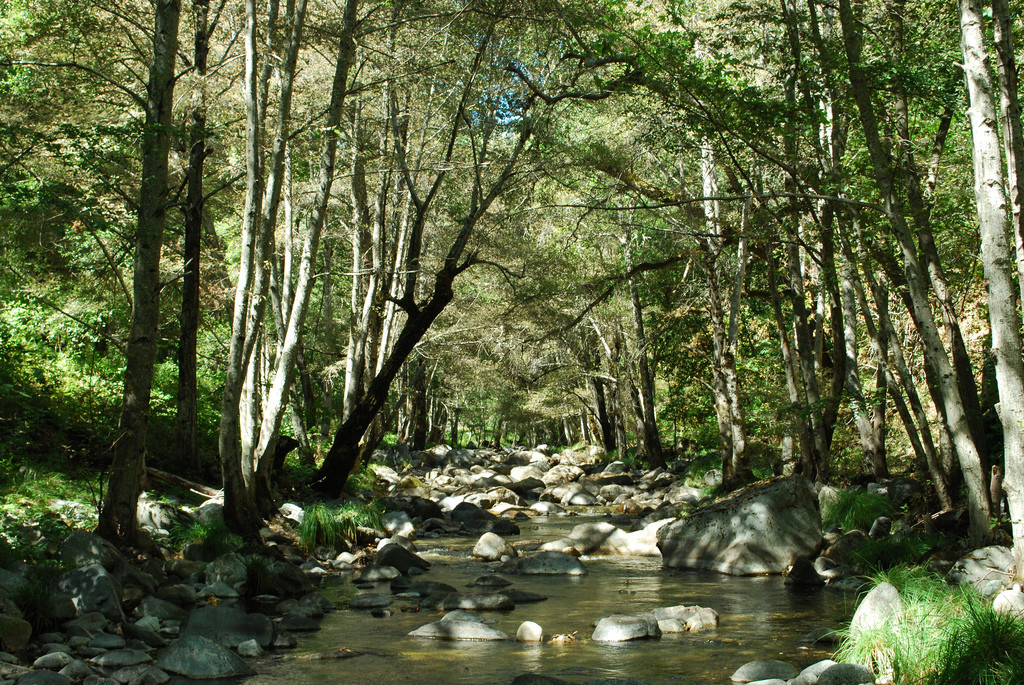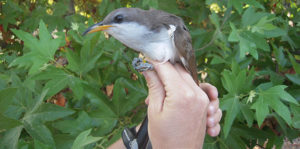Coccyzus americanus occidentalis
- Threatened – Endangered Species Act (2014)
Overview
A temperate migrant bird, the western yellow-billed cuckoo has a slender body with a long tail and rounded wings. The bird is one of two subspecies of Coccyzus (the other being Coccyzus americanus americanus on the east coast) and has historically ranged throughout most of the American west, including small portions of British Columbia, and northwestern Mexico. As an adult the bird plumage shows a grey top and white underside, with a defining black and white striped long tail. The bill is yellow and curved. As an adolescent the bird’s plumage is very similar to the adult but lacks the undertail banding.
Behavior
Cuckoos are generally shy; their elusive behaviors make them quite hard to locate. However, they are exceedingly vocal birds with a slow, rolling, guttural call. This loud call is a rapid staccato, kuk-kuk-kuk, which will usually slows and descends into a hollow and wooden sound, kakakowlp-kowlp. This gave the bird the nickname of the ‘rain crow.’ Yellow-Billed Cuckoos don’t lay their eggs all at once: the period between one egg to the next can stretch to as long as five days. This “asynchronous” egg laying means the oldest chick can be close to leaving the nest when the youngest is just hatching. If threatened, nesting pairs of Yellow-billed Cuckoos will react with a “distraction display” to lure potential predators away from the nest site. While one bird remains on the nest, the other hops to a visible perch, opening its wings and pumping its tail up and down. In open nesting areas, a bird flushed from the nest flutters away in a slow, wavering flight, flashing its rufous wing patches and white tail spots.

Riparian areas in the Los Padres National Forest are often prime habitat for the western yellow-billed cuckoo. Photo by David Stone.
Habitat
Nesting and foraging habitat is primarily among riparian cottonwood woodlands with healthy understory of vegetation and nests can usually be found in the arroyo willows. The Yellow-billed Cuckoos forage in treetops for caterpillars – sometimes eating one hundred caterpillars in one sitting. The larger populations of western yellow-billed cuckoos in the U.S. are in Arizona and New Mexico yet they can be found in the riparian corridors of the Los Padres National Forest as well – especially along healthy streams like the Sespe creek, or the Sisquoc River.
Threats & Conservation
Populations in the western United States are declining fairly rapidly and are of considerable conservation concern. Cuckoos depend on riparian corridors, which are under increasing pressure from exotic plants, water impoundment, and other factors. The western yellow-billed cuckoo was officially listed as threatened under the Endangered Species Act in 2014, at which time the U.S. Fish & Wildlife Service also designated critical habitat for the subspecies. Los Padres ForestWatch works to preserve the yellow-billed cuckoo by pushing for further Wild and Scenic River designation, and ensuring that the riparian corridors of the Los Padres remain free of trash and pollutants, and are preserved for all whom it supports.







